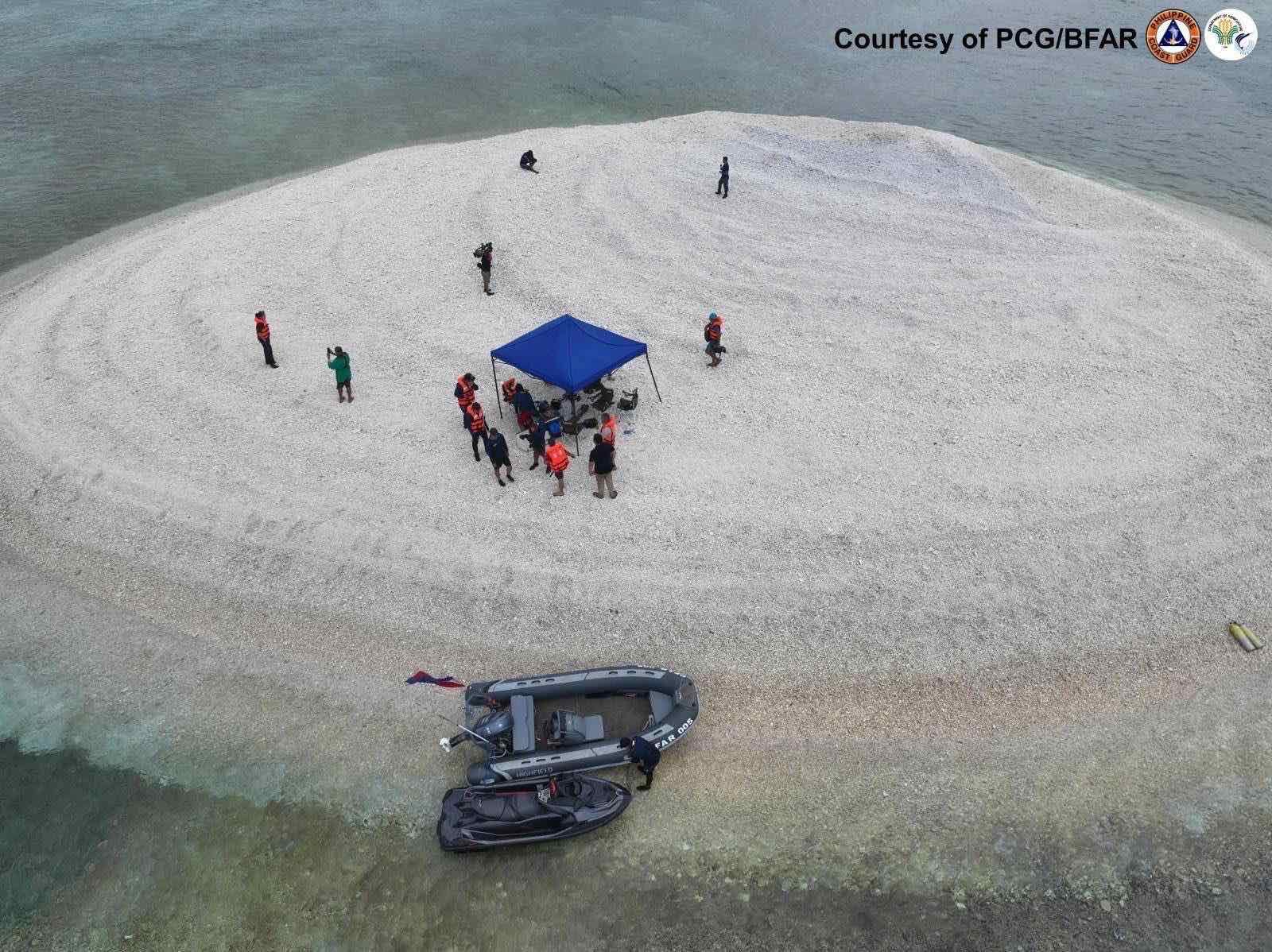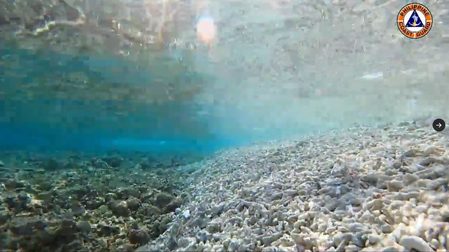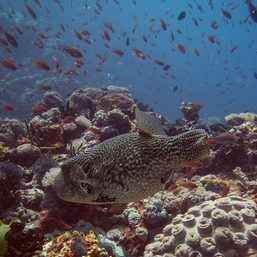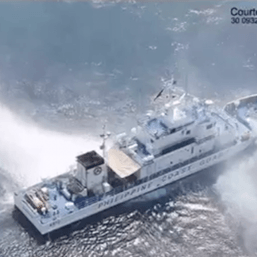SUMMARY
This is AI generated summarization, which may have errors. For context, always refer to the full article.

MANILA, Philippines – A Philippine Coast Guard (PCG) official said China should be held accountable for environmental damage in and near Pag-asa Island (Thitu), located 300 nautical miles from Palawan.
“So, if there is one country that we need to [hold] accountable dito sa damage sa environment na ito, sa ating coral reef dito sa Cays (for the damage to the environment, for our coral reef in Cays), that will only be the People’s Republic of China,” PCG spokesperson for the West Philippine Sea Commodore Jay Tarriela told reporters during Saturday News Forum on May 4.
“And if you are going ask me now who is our suspect in doing illegal small island reclamation in the Cays 1, 2, 3, 4…there’s no other country that we can pinpoint ‘no – it’s only the People’s Republic of China,” the PCG spokesperson added.
Professor Jonathan Anticamara from the University of the Philippines (UP) Institute of Biology said during the forum that many corals in Pag-asa Island, including the cays (a low island or reef of sand or coral), were now in a degraded state. Anticamara said many of the corals were small, while the large ones were dead. He added there were not much live corals and fish in the area.
“Pag-asa coral reefs, the cay, the Pag-asa Island itself have coral reefs that are now experiencing either a decline or degradation, overfishing, and the habitat itself is not in a good condition,” Anticamara explained.
“Although all throughout the Philippines, there’s degradation occurring, but I was surprised that Pag-asa itself, which is very far from a lot of fishers and from the mainland, is also suffering degradation.”
The UP professor added they also observed piles of rubble, which were most likely “made by human.” Anticamarara said the rubble was also too high; over the height of a person. Rubbles are indication of environmental destruction in the area, since these rubbles could be from broken corals.
Tarriela explained that Anticamara’s findings about the rubbles meant the Cays 1, 2, 3, and 4 have widened, but not because of natural occurrences. He said the rubbles used for the cays were dead corals, adding that they have yet to determine if the corals were intentionally destroyed or not.
However, Tarriela alluded that China could be the suspect behind this occurrence.
“Well, we have the same suspect na naiisip ninyo (that you may think of), and I think it is also the suspect that I have on my head. There’s no other suspect that we can name with these kind of activities ‘no, it’s only the People’s Republic of China for all the, of course, circumstances that I would highlight,” the PCG official said.
Explaining his statement, Tarriela said that aside from the Philippines, China is the other country near the cays. He added that China has the “professional record” in terms of reclamations in the South China Sea.
Another complaint?
Jay Batongbacal from the UP Institute for Maritime Affairs and Law of the Sea said the new findings could be a basis for another complaint that will be filed by the Philippines against China. In 2016, the Philippines won its maritime case against China in the Hague, which upheld the country’s claims in features located within its exclusive economic zone.
“Mahalagang punto ‘to kasi nga, noong time noong arbitration, hindi pa ‘yan napapansin, pero after the arbitration, iyon na (This is an important point because, at the time of the arbitration, we were not yet familiar with the development in Pag-asa Island, we only knew about it after the arbitration),” Batongbacal said during the forum.
In 2023, the Office of the Solicitor General (OSG) said it was studying the option of filing another complaint against China over the destruction of coral reefs within Philippine territory. The OSG’s statement came after the Armed Forces of the Philippines raised alarm over the suspected massive illegal harvesting of corals in Rozul Reef in the West Philippine Sea.
After the OSG’s statement, the Department of Justice (DOJ) later said the Philippines will pursue a complaint against China. DOJ Secretary Jesus Crispin “Boying” Remulla said in 2023 they hope to get the complaint ready by early 2024 – March “at the latest.”
Why this matters
Pag-asa Island is the farthest island territory of the Philippines. It is located beyond the country’s exclusive economic zone; more than 200 nautical miles from the Philippine territorial baseline. It is also located in the Spratlys, an archipelago in the South China Sea.
Although far, the island is a “vital frontier for Philippine sovereignty and community welfare,” according to the PCG. The island houses a small population of Filipinos, which include soldiers and coast guard staff.
Pag-asa Island is the biggest and most strategically important feature in the Spratlys. It is near Subi Reef, one of seven artificial islands that China has built using submerged reefs.
These recent findings that Pag-asa’s coral reefs and cays are experiencing degradation are a cause for alarm. Coral reefs, large marine structures that serve as habitats for marine life in the sea, are extremely important for marine biodiversity.
Meanwhile, cays, also known as sandbars, are important in ecosystems because they provide home to plants and animals. Sandbars are also vital to beach stability because they can reduce the energy of waves, which can also prevent severe erosion. – Rappler.com
Add a comment
How does this make you feel?











![[PANOORIN] Paninindigan ng mga sibilyan sa Pag-asa Island](https://www.rappler.com/tachyon/2024/05/TITLECARD-1.png?resize=257%2C257&crop=421px%2C0px%2C1080px%2C1080px)
![[Judgment Call] Philippine seas and a healthy dose of transparency](https://www.rappler.com/tachyon/2024/05/judgement-call-ayungin-shoal-may-16-2024.jpg?resize=257%2C257&crop=316px%2C0px%2C720px%2C720px)
![[Rappler Investigates] Deal or no deal, Duterte?](https://www.rappler.com/tachyon/2024/05/deal-or-no-deal-duterte-may-16-2024.jpg?resize=257%2C257&crop=422px%2C0px%2C1080px%2C1080px)

There are no comments yet. Add your comment to start the conversation.